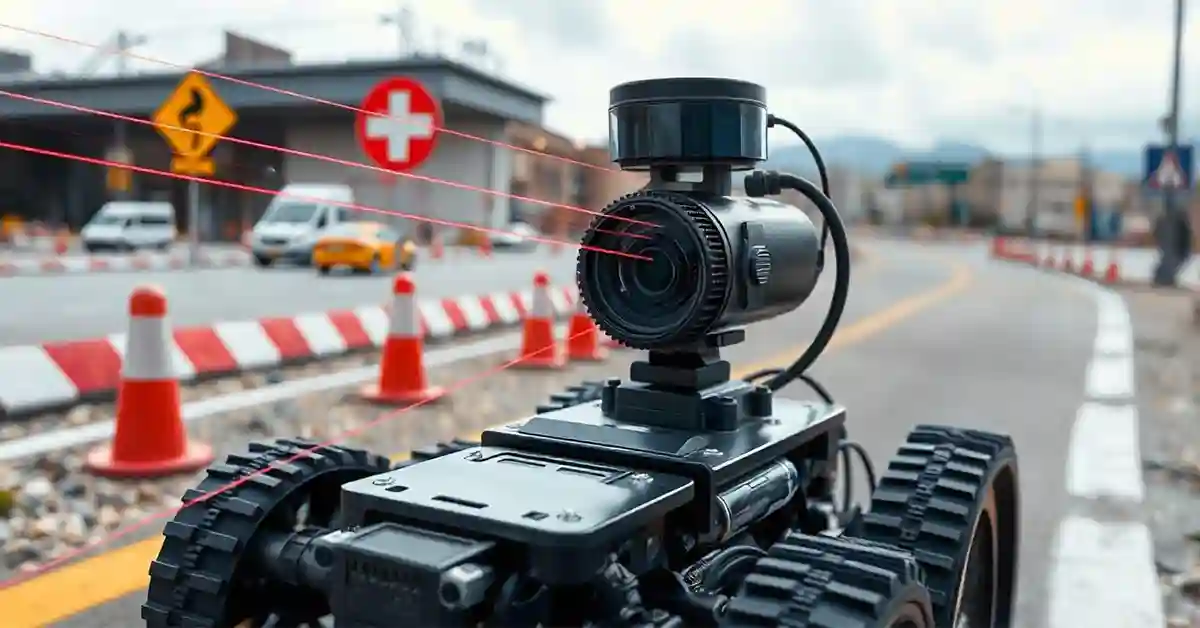In the fast-paced world of technology, understanding how devices perceive their surroundings can be both fascinating and essential. Picture a world where machines not only see but understand their environment with precision. That’s the frontier we’re exploring with SLAM LiDAR scanners and mono cameras. These technologies are transforming industries from robotics to autonomous driving by providing different ways for machines to interpret their surroundings.
What is the difference between a SLAM LiDAR scanner and a mono camera? This question often arises as tech enthusiasts and innovators seek to understand which technology offers better accuracy, efficiency, and applications. SLAM LiDAR scanners are known for their ability to create detailed 3D maps by firing laser beams and calculating the time it takes for them to return. In contrast, mono cameras capture images as a single-point perspective, similar to how we view the world through our eyes.
Both technologies have their unique advantages and challenges. In this article, we’ll explore how each technology works, its applications, and which one might be the better choice for specific situations. Join us as we unravel the potentials and challenges of these groundbreaking technologies and discover how they are shaping the future of machine perception.
Understanding SLAM LiDAR Technology
SLAM, or Simultaneous Localization and Mapping, is a cutting-edge technology that allows devices to map their surroundings in real-time while keeping track of their location within that space. LiDAR, which stands for Light Detection and Ranging, uses laser beams to create these maps. By measuring the time it takes for the laser to bounce back, the device can create a highly detailed 3D representation of its environment.
This technology is particularly useful in scenarios where precise mapping and positioning are crucial. For example, in autonomous vehicles, SLAM LiDAR helps the car “see” the road, obstacles, and other vehicles, ensuring a safe driving experience. It’s like having a digital map that updates in real-time as the environment changes.
With its ability to provide a rich, three-dimensional view, SLAM LiDAR is often the go-to choice for industries that require accurate spatial data. But how does it compare to the more traditional mono camera?
The Basics of Mono Camera Technology
Mono cameras capture images from a single perspective, similar to how a human eye perceives the world. These cameras are widely used in various applications due to their simplicity and cost-effectiveness. Unlike SLAM LiDAR, which generates 3D maps, mono cameras provide 2D images that can be processed to extract valuable information about the environment.
In applications like surveillance or photography, mono cameras excel due to their high-resolution imagery and ability to capture colors and textures. They are also commonly used in computer vision systems where visual cues are used to identify objects or track movement.
However, mono cameras rely heavily on sophisticated algorithms to interpret depth and spatial relationships, which can be a limitation in environments that require precise measurement.
Comparing Accuracy and Precision
When it comes to accuracy, SLAM LiDAR scanners have a distinct advantage. By using lasers to measure distances, they can create highly accurate 3D models of an environment. This precision is crucial in applications like robotics and autonomous vehicles, where understanding the exact position of objects can mean the difference between success and failure.
On the other hand, mono cameras, while capable of high-resolution images, rely on software to infer depth and position. This means that their accuracy can be affected by factors such as lighting conditions or object textures. In dynamic environments, this can pose a challenge.
For engineers and developers, choosing between these technologies often involves weighing the need for precision against other factors like cost and complexity.
Cost-Effectiveness and Scalability
Cost plays a significant role in deciding between SLAM LiDAR and mono cameras. Generally, mono cameras are more cost-effective and easier to scale. This makes them an attractive option for applications where budget constraints are a significant consideration, such as consumer electronics or large-scale surveillance systems.
SLAM LiDAR, while offering superior accuracy, tends to be more expensive due to the complexity of its components and the sophistication of its processing requirements. This can limit its use to industries where precision cannot be compromised, despite the higher costs.
For startups and businesses looking to integrate vision technology, understanding these cost dynamics is key to making an informed decision.
Practical Applications in Robotics
Robotics is one area where both SLAM LiDAR and mono cameras find significant applications. SLAM LiDAR is often preferred for navigation and obstacle avoidance due to its ability to create accurate and detailed maps. Robots equipped with LiDAR can move around complex environments, identify obstacles, and plan paths efficiently.
Mono cameras, meanwhile, are used in applications that require image recognition or tracking. For example, in robotic arms used in manufacturing, mono cameras can be employed to recognize parts or align components with precision.
The choice between the two often depends on the specific task the robot is designed to perform.
Autonomous Vehicles and Navigation
In the field of autonomous vehicles, SLAM LiDAR and mono cameras are often used together to provide a comprehensive understanding of the vehicle’s surroundings. LiDAR offers detailed 3D maps that help in precise navigation, while mono cameras provide visual information that can detect traffic signals, road markings, and pedestrians.
This combination allows autonomous cars to make informed decisions in real-time, ensuring safety and efficiency on the road. However, some manufacturers are exploring camera-only solutions to reduce costs and simplify systems, although this approach requires highly advanced algorithms to compensate for the lack of depth information.
Environmental Mapping and Surveying
SLAM LiDAR is a popular choice for environmental mapping and surveying due to its ability to capture intricate details of terrain and structures. This makes it invaluable in industries such as agriculture, mining, and architecture, where understanding the land is crucial.
Mono cameras can also be used in these fields, particularly when color and texture information is essential. However, they often need to be paired with additional sensors to achieve the level of detail provided by LiDAR.
Selecting the right tool for mapping depends largely on the project’s specific needs and objectives.
Challenges and Limitations
While both SLAM LiDAR and mono cameras offer substantial benefits, they also come with their own set of challenges. SLAM LiDAR systems can be complex to implement, requiring significant processing power and integration expertise. They are also susceptible to issues like poor performance in adverse weather conditions.
Mono cameras, on the other hand, face limitations in depth perception and can struggle in low-light environments. They often rely on advanced algorithms to overcome these challenges, which can add complexity and affect performance.
Understanding these limitations is crucial for engineers and developers as they work to integrate these technologies into practical applications.
Innovations and Future Developments
The field of vision technology is rapidly evolving, with continuous advancements in both SLAM LiDAR and mono camera systems. Researchers are working on developing more efficient algorithms, improving sensor technologies, and reducing costs to make these solutions more accessible.
Future developments may see hybrid systems that combine the strengths of both technologies to offer unparalleled accuracy and versatility. Such innovations hold the promise of transforming industries and creating new opportunities for tech enthusiasts and engineers alike.
Staying informed about these trends is essential for those looking to harness the power of vision technology in their projects.
Deciding Factors for Engineers and Innovators
For engineers and innovators tasked with choosing between SLAM LiDAR and mono cameras, several factors come into play. These include the specific application requirements, budget constraints, and the desired level of accuracy.
Ultimately, the decision may also be influenced by the availability of expertise and resources to implement and maintain these technologies. Collaborating with experts and conducting thorough research can ensure that the chosen solution aligns with project goals and delivers optimal results.
Real-World Case Studies
Exploring real-world case studies can provide valuable insights into how SLAM LiDAR and mono cameras are being used effectively across different industries. For instance, autonomous drones equipped with LiDAR are revolutionizing agricultural monitoring, while mono cameras are enhancing security systems with advanced facial recognition capabilities.
These examples highlight the diverse applications and benefits of each technology, offering inspiration and guidance for those developing their own solutions.
FAQs With Answers
What is the main difference between SLAM LiDAR and mono cameras?
SLAM LiDAR uses laser beams to create 3D maps of environments, making it highly accurate for spatial measurements. Mono cameras capture 2D images and rely on software to interpret depth, making them suitable for applications needing detailed visual information.
Are SLAM LiDAR systems more expensive than mono cameras?
Yes, generally SLAM LiDAR systems are more costly due to their sophisticated components and processing requirements, whereas mono cameras are more budget-friendly and scalable.
Which technology is better for autonomous vehicles?
Both technologies have their merits. SLAM LiDAR provides detailed 3D mapping crucial for navigation, while mono cameras offer essential visual information like traffic signals and signs. A combination is typically used for best results.
Can mono cameras be used for mapping terrains?
Mono cameras can be used for mapping when paired with other sensors to provide depth information. They excel in applications where color and texture data are important but may require additional tools for detailed topography.
What future advancements are expected for these technologies?
Future advancements in SLAM LiDAR and mono cameras include improved algorithms, better sensor technology, and reduced costs. Innovations may lead to hybrid solutions that offer enhanced accuracy and functionality.
Conclusion
In the rapidly advancing world of technology, understanding the capabilities and limitations of SLAM LiDAR and mono cameras is vital for tech enthusiasts, engineers, and innovators. These technologies offer unique ways to perceive and interpret the world, each with its own advantages and challenges.
SLAM LiDAR is unparalleled in its ability to create precise 3D maps, making it invaluable for applications requiring detailed spatial data. Meanwhile, mono cameras provide high-resolution imagery and visual information that are crucial in numerous fields.
Choosing the right technology ultimately depends on the specific requirements of your project, including desired accuracy, budget, and scalability. By staying informed and exploring real-world applications, you can effectively leverage these technologies to innovate and transform industries.
For those eager to explore more, consider experimenting with both SLAM LiDAR and mono camera systems to discover new possibilities and drive technological advancement.










